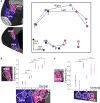Two Distinct Scene-Processing Networks Connecting Vision and Memory
- PMID: 27822493
- PMCID: PMC5075944
- DOI: 10.1523/ENEURO.0178-16.2016
Two Distinct Scene-Processing Networks Connecting Vision and Memory
Abstract
A number of regions in the human brain are known to be involved in processing natural scenes, but the field has lacked a unifying framework for understanding how these different regions are organized and interact. We provide evidence from functional connectivity and meta-analyses for a new organizational principle, in which scene processing relies upon two distinct networks that split the classically defined parahippocampal place area (PPA). The first network of strongly connected regions consists of the occipital place area/transverse occipital sulcus and posterior PPA, which contain retinotopic maps and are not strongly coupled to the hippocampus at rest. The second network consists of the caudal inferior parietal lobule, retrosplenial complex, and anterior PPA, which connect to the hippocampus (especially anterior hippocampus), and are implicated in both visual and nonvisual tasks, including episodic memory and navigation. We propose that these two distinct networks capture the primary functional division among scene-processing regions, between those that process visual features from the current view of a scene and those that connect information from a current scene view with a much broader temporal and spatial context. This new framework for understanding the neural substrates of scene-processing bridges results from many lines of research, and makes specific functional predictions.
Keywords: memory; networks; scene; vision.
Figures






References
-
- Baker K (2012) Identity, memory and place. The Word Hoard 1:Article 4.
Publication types
MeSH terms
Grants and funding
LinkOut - more resources
Full Text Sources
Other Literature Sources
Medical
